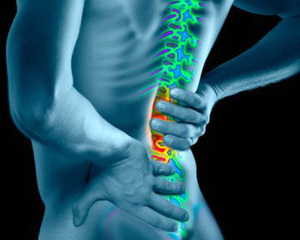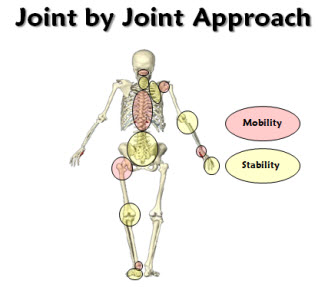Where is your pain coming from?
This article is for you if:
- As the Doctor or Therapist, you have patients which keep coming back with the same condition
- You are not getting the results which you think you should
- As a patient, you have had the same problem for years, and/or a new problem that started out of nowhere and have no idea what caused it
These questions can be answered very easily, by using a new way of thinking. I will try to make it as easy as possible.
Site vs Source Debate.
The site vs source debate is a relatively new idea for many Doctors and Therapists, unless you are familiar with the Functional Movement Systems.
- The site is where your pain is coming from
- This is pretty easy from most experienced clinicians. The use of a History, Physical Exam, Orthopedic Tests, Palpation, Muscle Testing, Pain Referral diagrams, Imaging, etc will often point you to the specific tissue causing the problem.
- Obviously there are more difficult cases where pain could be a viscerosomatic referral (organs referring pain to the musculoskeletal system) or a systemic problem like Diabetes or Autoimmune conditions. Your Dr. should be able to rule out Red Flags.
- Using just the site of pain for treatment might not be the best approach. You are treating a condition or tissue using only half the story.
- It is often times effective to short term pain management, but often yields poor results in long term pain management.
- These are the patients, or it may be yourself, that have had the same problem for many years, and it goes away but keeps coming back.
- The source of pain however, is what is causing the pain. This is the other half of the story.
- This is the more difficult problem for clinicians and people to understand.
- Oftentimes the source of pain is a different area of the body and/or tissue than the site of pain.
- The Selective Functional Movement Assessment (SFMA) is the best way to determine the source of pain.
- The SFMA provides you with a Functional Movement Diagnosis, which is different than a Medical Diagnosis.
- A Medical Diagnosis would be low back pain.
- A Functional Movement diagnosis would be lack of thoracic spine mobility either from a joint problem or muscle tightness.
- This is the more difficult problem for clinicians and people to understand.
The easiest way I can explain the Source of pain
- I eluded to this statement earlier (but a very important concept), the source of pain is often a different tissue than the site.
- The site of pain is often the tissue which is working properly or the overworked tissue, which is why it hurts, while the source is the tissue which is not working properly, and doesn’t hurt.
Examples explaining site vs source
- Ice block analogy
- Let’s say you and your best friend are moving big pieces of ice from one place to another. If there is 20 pieces of ice, so you each only have to do 10.
- After only 2 trips, your friend gets tired and says, “I can’t carry anymore ice.” So you have to do the rest of your ice by yourself.
- After you get done moving all the ice, who is the one hurting? Of course you are because you had to do all the work and your friend didn’t do the work.
- Your friend is the source of pain (the one who isn’t doing the work) and you are the site of pain (you did all the work)
- Smashing finger with hammer
- You come to me with a hurt finger. I do some magic on your finger and it no longer hurts. You come back the next day, with the same thing. I do some more magic, your finger doesn’t hurt and you come back again with the same thing.
- I get tired of treating your finger and finally ask you why your finger keeps hurting. You tell me well I keep smashing it with a hammer.
- Your finger is the site of the pain, and the hammer is the source. If I did not determine the source of the pain, we would keep going in that cycle of treating your hurt finger. I tell you not to smash your finger with the hammer and your finger stops hurting.
Concepts of site vs source of pain
- Joint by Joint
- The body is designed in an alternating pattern of how your joints work. They work and build upon each other for movement. One joint creates stability and allows the next joint to move (stability). Your foot is a stable platform to allow your ankle joint to move.
- If one joint loses its ability to move. The next joint either above or below, loses its ability to stabilize, and becomes a mobile joint.
- That becomes a problem because it then becomes overworked, just like the Ice analogy.
- Regional Interdependence
- Defined as, “Seemingly unrelated impairments in a remote anatomical region may contribute to or be associated with the patient’s primary complaint.”
- Your body (the whole) is greater than the sum of its parts.
- It doesn’t make sense to me to try to understand impairments of different parts of the body without first understanding the function of the body as a whole (your movement).
Most common sources and sites
- Site: Low back pain
- Sources: Lack of thoracic spine and/or hip mobility
- Research shows there is a correlation between loss of hip internal rotation and LBP
- Sources: Lack of thoracic spine and/or hip mobility
- Site: Shoulder and/or neck pain
- Source: Lack of thoracic mobility
- Site: Knee pain
- Source: Lack of hip/or ankle mobility (dorsiflexion)
- Research shows altered both ankle and hip mechanics can affect knee mechanics
- Source: Lack of hip/or ankle mobility (dorsiflexion)
- There are many other possibilities, I only gave you the most common ones.
What to do
- Find someone who knows the Functional Movement Systems to get you assessed. However, currently the SFMA does not have a provider list.
- Other options
- Google Movement Specialist in your area
- Find a TPI Medical Level 2 or 3 Professional. Even if you are not a golfer, TPI uses the SFMA as their medical exam and will most likely still help you.
- Search for Active Release Technique (ART) providers near you. Oftentimes ART practitioners also are SFMA certified.
Conclusion
- The site of your pain is where it hurts. This tells you very little about your condition, except where it hurts. It does not tell you why it hurts.
- The source is the tissue/body part that is not functioning properly. It tells and can explain why you hurt where you hurt.
- If you do not find the source, your pain/condition will most likely keep coming back.
- A Functional Movement Diagnosis tells me what to do.
- A Medical Diagnosis is good for knowing what tissue is damaged, but gives me little information as to why that tissue is damaged.
Good Luck finding your source of pain!


